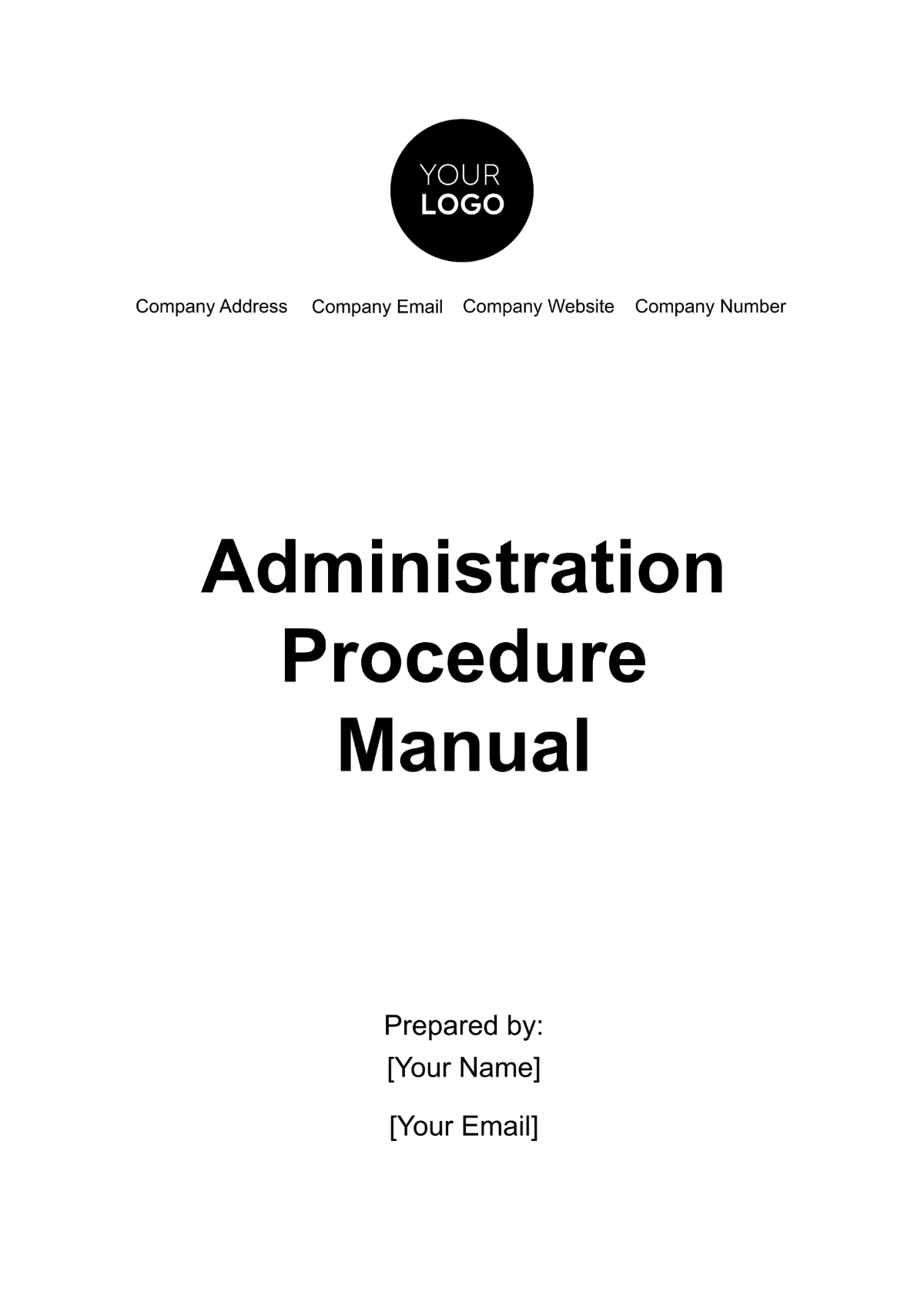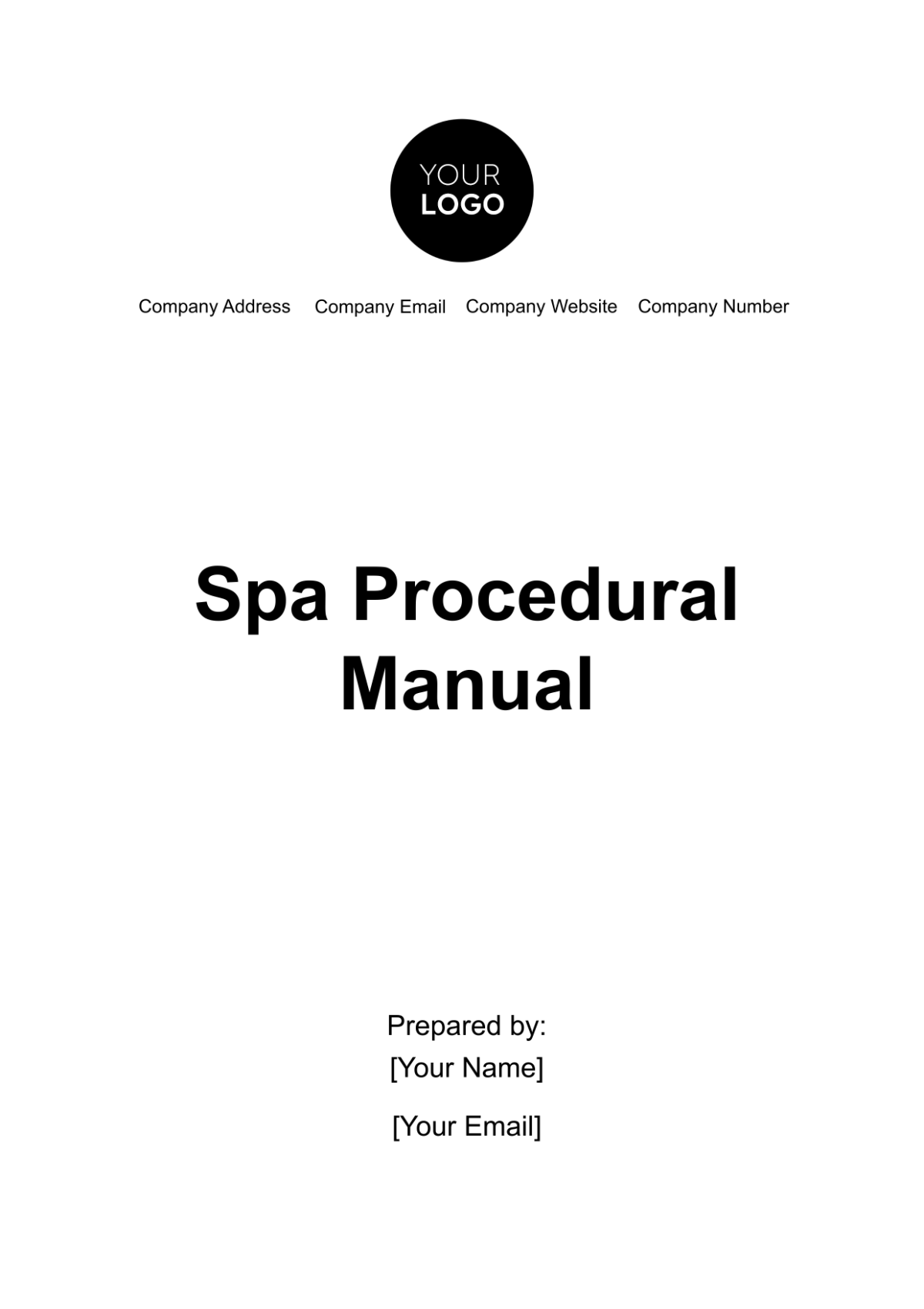Accounting Asset Policies & Procedures Manual
I. Introduction
A. Purpose of the Manual
The primary purpose of this manual is to provide a systematic approach to asset management, offering a unified understanding of the principles that underpin the treatment of tangible and intangible assets. It aims to equip our company with a set of guidelines that foster efficiency, transparency, and compliance in all facets of asset-related activities.
B. Significance of Asset Management
Effective asset management is integral to the financial health and operational success of our company. By defining and classifying assets, establishing acquisition and recording procedures, determining depreciation and amortization methods, and outlining protocols for asset disposal, this manual serves as a comprehensive resource for maintaining accurate financial records and making informed strategic decisions.
C. Alignment with Industry Standards
In recognizing the dynamic nature of accounting standards, this manual is designed to remain adaptable to evolving industry practices and regulatory requirements. It provides a foundation for our company to stay in sync with the latest standards, ensuring that asset management practices consistently meet or exceed the benchmarks set by regulatory bodies.
D. User Guidance
To maximize the utility of this manual, it includes user-friendly guidance to aid stakeholders in understanding and implementing the outlined policies and procedures. Whether for new employees navigating asset-related responsibilities or seasoned professionals seeking clarification, this manual is a reference tool designed to streamline asset management processes.
E. Commitment to Continuous Improvement
Emphasizing a commitment to excellence, this introduction underscores the dynamic nature of asset management within our company. It encourages a culture of continuous improvement, prompting periodic reviews and updates to the manual to reflect advancements in accounting practices and technological innovations.
II. Definition and Classification of Assets
In the realm of accounting, assets are the backbone of a company's financial landscape, representing resources that contribute to its overall value. Understanding their nature and classification is crucial for effective financial management. Assets can be broadly categorized into two main types:
A. Tangible Assets
Land
Refers to real property owned by the company, providing a physical foundation for business operations. Whether utilized for operational facilities or held for investment, land holds intrinsic value and contributes to the company's net worth.
Buildings
Physical structures such as offices, factories, or warehouses fall under this category. Buildings not only house the company's activities but also represent significant investments that impact financial statements.
Machinery and Equipment
Tools and machinery play a vital role in production processes. These tangible assets contribute directly to operational efficiency and are essential for maintaining a competitive edge in the market.
Vehicles
Company-owned vehicles, whether for logistics or employee use, are tangible assets. Their proper management is crucial for optimizing transportation operations and minimizing associated costs.
Stock
Physical inventory represents a tangible asset that contributes to the company's operational activities. Efficient stock management ensures optimal inventory levels, facilitating smooth business operations.
Cash
The physical currency on hand and cash reserves represent tangible assets that contribute to liquidity. Efficient cash management is crucial for day-to-day financial transactions and provides the company with financial flexibility.
B. Intangible Assets
Patents
Exclusive rights granted for an invention provide the company with a competitive advantage. Patents safeguard innovations, fostering an environment conducive to research and development.
Copyrights
Protection for creative works, such as literature or software, ensures the company's intellectual property is safeguarded. Copyrights not only protect original creations but also serve as assets with potential monetary value.
Franchises
Acquiring the rights to operate under an established brand or business model can enhance the company's market presence. Franchises represent intangible assets that contribute to brand recognition and customer trust.
Goodwill
This intangible asset represents the positive reputation and relationships the company has built with customers and stakeholders. Goodwill plays a crucial role in brand value and can impact the company's overall worth.
Trademarks
Symbols or names identifying products or services contribute to brand recognition. Trademarks represent intangible assets that help build brand loyalty and differentiate the company in the market.
III. Acquisition and Recording of Assets
A. Acquisition Procedures
Vendor Assessment and Selection
Before acquiring any asset, a thorough assessment of potential vendors is imperative. The company must evaluate not only the cost but also the reliability, reputation, and adherence to ethical standards of prospective vendors. A rigorous vendor selection process ensures that assets are sourced from reputable suppliers, contributing to long-term reliability and fostering strong business relationships.
Due Diligence and Approval
Rigorous due diligence procedures should be followed for high-value acquisitions. This involves a meticulous examination of legal, financial, and operational aspects to mitigate risks. Approval processes should involve cross-functional teams to ensure a well-rounded assessment and alignment with strategic goals. The due diligence phase serves as a proactive measure to identify and address potential challenges before they impact the organization.
Documentation and Contractual Clarity
Accurate and comprehensive documentation is paramount in the acquisition process. Contracts should explicitly outline terms, conditions, warranties, and delivery timelines. This not only serves as a legal safeguard but also provides a clear reference point for both parties, fostering transparency and accountability. Clarity in contractual agreements is vital for avoiding misunderstandings and disputes, contributing to smoother operations.
Budgetary Alignment
Acquisitions must align with the company's budgetary constraints and strategic financial goals. Budget approvals should be obtained from relevant stakeholders to ensure financial prudence and avoid unforeseen financial strain. Aligning acquisitions with the budgetary framework contributes to effective resource allocation and supports the organization in achieving its financial objectives.
B. Recording Procedures
The table below illustrates the key steps involved in the Recording Procedures for asset management:
These steps ensure a systematic and accurate recording process, contributing to the overall effectiveness of asset management in [Your Company Name]. Now, let's delve into the specifics of each step:
Ensure Timely Recording in Ledgers
To maintain accuracy, promptly record details of newly acquired assets into the financial ledgers. This includes capturing essential information such as purchase date, cost, and supplier details. Utilize a standardized process to ensure consistency in recording, preventing delays and inaccuracies.
Perform Categorization and Classification
Systematically categorize assets based on their nature, usage, and financial significance. Establish a standardized classification system, incorporating criteria relevant to the organization's operations. This systematic approach enhances reporting clarity and facilitates efficient decision-making by providing a structured overview of asset composition.
Conduct Verification and Validation
Implement robust verification processes to ensure the accuracy of recorded asset data. Regularly validate recorded information through cross-referencing with supporting documentation. This includes invoices, receipts, and other relevant records. This step is crucial for maintaining data integrity and upholding the reliability of financial reporting.
Ensure Documentation Compliance
Adhere to stringent documentation standards and record-keeping policies. Clearly outline the required documentation for each asset, ensuring consistency across the organization. Regularly audit documentation practices to confirm compliance with accounting standards and regulatory requirements. This step contributes to the transparency of financial records, fostering trust with stakeholders and regulatory bodies.
IV. Depreciation and Amortization
A. Depreciation Procedures
Method Selection
In initiating the depreciation process, the first pivotal step involves the careful selection of an appropriate method for tangible assets. Evaluation of options such as straight-line, declining balance, or units of production is essential, taking into account the unique characteristics of each asset and its expected useful life. This thoughtful consideration forms the basis for ensuring accurate and equitable representation of asset depreciation.
Accurate Calculation
The precision of depreciation calculations is critical for providing an accurate reflection of the company's financial standing. Once the depreciation method is chosen, consistent application is imperative. Regular updates to the depreciation schedule should be made to accommodate any changes in an asset's expected useful life or salvage value, ensuring precision in financial reporting.
Financial Reporting Compliance
Adherence to financial reporting standards is a fundamental aspect of depreciation procedures. Strict adherence to these standards in the calculation and recording of depreciation not only ensures transparency in financial dealings but also demonstrates compliance with established accounting regulations. This commitment fosters trust among stakeholders, providing them with reliable and compliant financial information.
B. Amortization Procedures
Methodology for Intangible Assets
For intangible assets, such as patents, copyrights, and franchises, a systematic approach to amortization is crucial. Selecting an appropriate method and determining the asset's useful life are key components. This ensures a consistent and fair representation of the asset's value over time.
Consistent Recording and Updates
Similar to tangible assets, accurate and consistent recording of amortization is vital. Regular updates to the amortization schedule should be made to reflect any changes in the asset's useful life or impairment. This proactive approach ensures that the company's financial records accurately mirror the evolving value of intangible assets.
Adherence to Regulatory Standards
As with depreciation, compliance with regulatory standards is paramount in amortization procedures. Following established accounting regulations for intangible assets demonstrates the company's commitment to financial transparency and adherence to industry standards. This, in turn, enhances the credibility of financial reports and builds trust among stakeholders.
V. Asset Disposal
A. Disposal Policies
Maximizing Returns
When disposing of assets, the overarching goal is to maximize potential returns. Establishing clear policies on evaluating the condition of assets and determining the most lucrative method of disposal ensures that the company extracts the maximum value from its assets, contributing to overall financial sustainability.
Minimizing Negative Impacts
Beyond financial considerations, disposal policies should also aim to minimize negative impacts on the environment and stakeholders. Implementing environmentally conscious practices, such as recycling or responsible waste disposal, aligns with sustainable business practices and enhances the company's corporate social responsibility (CSR) profile.
B. Record-Keeping
Thorough Documentation
Every asset disposal should be thoroughly documented. This includes recording the method of disposal, the date of disposal, and any proceeds generated. Comprehensive documentation not only ensures compliance with accounting standards but also provides a historical record that can be valuable for audits or legal purposes.
Integration with Financial Records
Seamless integration of asset disposal records with the company's financial records is essential. This integration facilitates accurate financial reporting by accounting for changes in the asset portfolio. It also aids in tracking the overall financial impact of asset disposals, contributing to informed decision-making.
Audit Trail Creation
Creating a detailed audit trail of asset disposals serves multiple purposes. It allows for transparency in financial reporting, aids in compliance verification during audits, and provides a clear history of the company's asset management practices. An audit trail is a valuable tool for demonstrating accountability and adherence to established procedures.
C. Responsible Disposal Methods
Environmental Considerations
Prioritize disposal methods that have minimal negative impact on the environment. This includes exploring recycling options or choosing methods that align with environmental regulations. Responsible disposal methods contribute to the company's commitment to sustainability.
Legal Compliance
Ensure that all asset disposals comply with relevant legal regulations. Understanding and adhering to legal requirements prevent potential legal issues and liabilities. This includes compliance with environmental laws, data protection regulations, and any industry-specific disposal regulations.
D. Employee Awareness
Disposal Procedure Familiarization
Provide comprehensive training to employees involved in the asset disposal process. Familiarize them with the company's disposal policies, legal requirements, and environmental considerations. Well-trained employees contribute to the smooth and compliant execution of asset disposals.
Security Measures
Emphasize the importance of security measures during asset disposal. Train employees on safeguarding sensitive information and ensuring that disposed assets, especially those containing confidential data, are handled securely. Employee training is crucial for minimizing data breaches and protecting the company's reputation.
E. Continuous Evaluation and Improvement
Periodic Review of Disposal Processes
Implement a system for the periodic review of asset disposal processes. Regular assessments ensure that the company's disposal methods remain effective, compliant, and aligned with industry best practices. Continuous evaluation contributes to the ongoing improvement of asset management practices.
Feedback Incorporation
Encourage feedback from employees involved in the disposal process and other relevant stakeholders. Actively incorporate constructive feedback to refine disposal procedures. This iterative approach promotes a culture of continuous improvement in asset management practices.
VI. Asset Valuation
The table below provides an overview of the key details involved in the asset valuation process:
Asset Type | Valuation Method | Appraisal Frequency | Responsible Department |
|---|---|---|---|
Tangible Assets | Market Value Approach | Annual | Finance and Accounting |
Intangible Assets |
Asset valuation is crucial for [Your Company Name] as it directly influences financial reporting, strategic planning, and overall transparency. Accurate valuation ensures that the company's financial statements reflect the true worth of its assets, providing stakeholders with reliable information. Regular appraisals align with industry standards and compliance requirements, reducing the risk of misrepresentation and supporting ethical business practices.
In the asset valuation process, different asset types are subjected to distinct valuation methods and appraisal frequencies. For tangible assets, the market value approach is employed, involving an annual assessment conducted by the Finance and Accounting department. These methods ensure that each asset's value is accurately reflected, contributing to informed decision-making and financial transparency. By emphasizing precise asset valuation, the company fosters trust among investors, regulatory bodies, and internal stakeholders, contributing to sustainable financial health.
VII. Internal Controls
A. Segregation of Duties
Define Roles and Responsibilities
Separate the tasks of acquiring assets from those responsible for recording and disposing of assets to prevent conflicts of interest.
Regularly Review and Update Role Assignments
Conduct periodic reviews of role assignments to accommodate changes in personnel or organizational structure. Ensure that segregation of duties remains effective even as roles evolve, reducing the risk of errors or fraud.
B. Physical Safeguards
Implement Secure Storage Procedures
Establish secure storage protocols for physical assets, ensuring that tangible assets are stored in designated and secure locations. Implement access controls and monitoring mechanisms to prevent unauthorized access.
Periodic Physical Audits
Conduct regular physical audits of tangible assets to verify their existence and condition. This includes cross-referencing physical counts with recorded asset information in the asset management system, maintaining accuracy.
C. Documentation and Record-Keeping
Standardize Documentation Procedures
Standardize the documentation process for asset acquisition, recording, disposal, and valuation. Ensure that all relevant information is consistently captured and stored in a centralized system, facilitating easy retrieval and analysis.
Regularly Audit Documentation Accuracy
Conduct routine audits of asset documentation to verify accuracy and completeness. Address any discrepancies promptly to maintain the integrity of the asset management records, enhancing reliability for decision-making.
D. Access Controls
User Access Levels
Establish tiered user access levels based on job roles and responsibilities. Limit access to sensitive asset information to only those individuals who require it for their duties, minimizing the risk of unauthorized access.
Regularly Review and Adjust Access Rights
Periodically review and adjust access rights to align with personnel changes or shifts in responsibilities. This ensures that individuals have the appropriate level of access required for their roles, enhancing data security.
E. Reporting and Monitoring
Automate Reporting Processes
Implement automated reporting mechanisms within the asset management system to generate regular reports on asset status, valuation, and any irregularities. Automation improves efficiency and reduces the likelihood of oversight.
Establish Monitoring Protocols
Set up monitoring protocols to receive alerts for any unusual activities or deviations from standard asset management procedures. Proactively address any identified issues, preventing potential risks from escalating.
VIII. Appendices
Internal Controls Checklist
A checklist outlining the key elements of internal controls for asset management, providing a quick reference for auditing and compliance purposes.
Asset Disposal Decision Matrix
A decision matrix providing a structured approach for evaluating options and making informed decisions during the asset disposal process.
Asset Maintenance Log
A log for recording and tracking routine maintenance activities performed on company assets, ensuring the longevity and optimal performance of assets.

















































